Holy See State Secretary arrives in Zagreb
ZAGREB, 11 May 2022 - The Vatican's State Secretary, Cardinal Pietro Parolin, arrived in Zagreb on Tuesday for a three-day visit during which he will meet with the highest Croatian religious and political leaders, the Zagreb Archdiocese said in a statement.
Parolin is visiting Croatia on the occasion of the 30th anniversary of its recognition and the 25th anniversary of the ratification of three agreements between the Holy See and Croatia.
The Vatican dignitary was welcomed at Zagreb Airport by a delegation headed by Zagreb Archbishop Josip Bozanić.
On Wednesday, Parolin will meet with members of the Croatian Bishops Conference, and later on the same day he will lead a religious service in Zagreb.
On Thursday, Cardinal Parolin is expected to meet with Prime Minister Andrej Plenković and Parliament Speaker Gordan Jandroković and address the parliament, after which he will meet with President Zoran Milanović, the Zagreb Archdiocese said.
For more, make sure to check out our dedicated lifestyle section.
Croatian and Bosnian Bishops Call for Equal Status of BiH Croats
ZAGREB, 15 Feb 2022 - Croatian and Bosnian bishops met on Tuesday in Mostar to warn that Croats in Bosnia and Herzegovina are outvoted and that they should be equal to the other two main ethnic groups, with Croatian Bishops' Conference (HBK) head Želimir Puljić voicing satisfaction with Croatia's improved care for them.
"Unfair laws enable the outvoting of the less numerous ones by the majority, with the Croats suffering most frequently," Sarajevo Archbishop Tomo Vukšić said at the meeting.
He added that the Church is constantly reminding the BiH authorities that they need to respect the rights of every man and the collective rights of every ethnic group. He called for "changing unfair legal solutions and adopting and implementing just laws." Addressing a press conference in Mostar, Archbishop Vukšić explained that as an "individual from the rank of Croats," he expected equal rights for all ethnic groups.
Zadar's Archbishop and HBK president Puljić said that he understands the frustrations of Croats in BiH, and that he is "happy to feel that Croatia is caring for its people in BiH."
"Seeing that it is a signatory to the Dayton Accord, Croatia has an obligation to care for the Croat people and in doing so, it cares about the entire country, which has been blocked for a long time," Puljić underscored. He said that he hoped BiH would soon "see the prospect of European Union membership," and that its EU membership bid was strongly supported by Croatia.
"I hope that Croatia will help BiH, notably Croats, to join the community of peoples as soon as possible," he added.
Bogojavljenje (Epiphany) - Three Kings Day in Croatia
January 6, 2022 – Thursday 6 January is Bogojavljenje (Epiphany). Three Kings Day in Croatia is a national holiday. It is also a day marked by its own historic and very distinct traditions.
With the fireworks of New Year's Eve almost one week behind us, Christmas already feels like it was quite a while ago. But, with church bells ringing out across the land, Three Kings Day arrives on 6 January to remind us in Croatia that we're not quite finished yet.
Commonly known as Bogojavljenje (Epiphany), Three Kings Day is highly significant in the Catholic calendar. It is also a day of limited but extremely distinct tradition in Croatia. Understanding these traditions requires a comprehension of some Bible scriptures. More so, perhaps, than the traditions of any other feast or celebration days connected to Christmas.
What is Bogojavljenje (Epiphany) - Three Kings Day in Croatia?
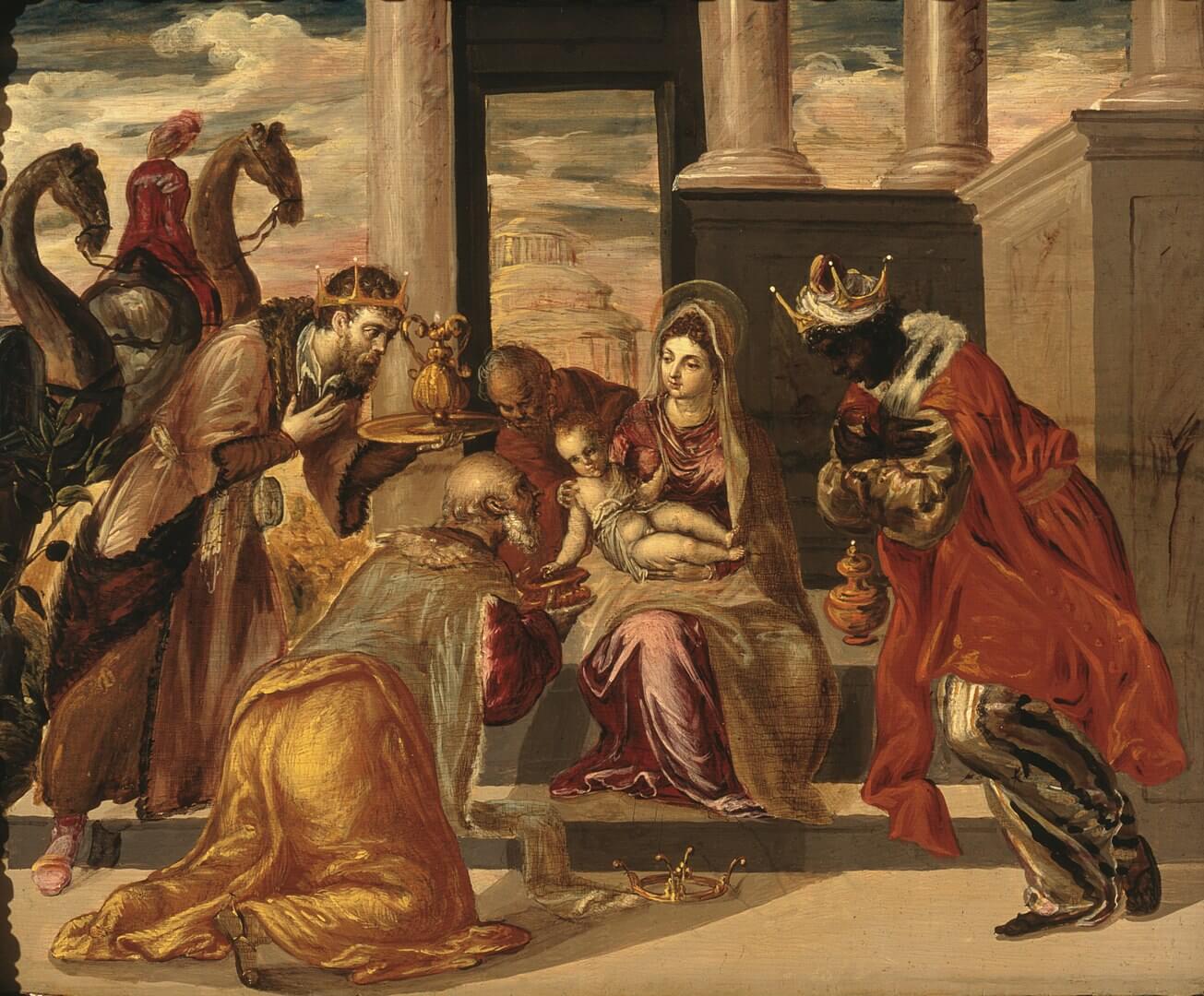 Adoration of the Magi by El Greco
Adoration of the Magi by El Greco
January 6 is celebrated in the Catholic church as both Epiphany and the day of the Three Kings. Epiphany is the revelation of Jesus as the Son of God to those outside Judaism. Three Kings Day is when the three kings – otherwise known as Magi or the three wise men - visit the newly-born Jesus and present gifts to him.
These could look like two different celebrations that just happen on the same day. But, in fact, they are not at all separate. Although, their connection does take some explaining. And the traditions the day creates in Croatia takes even more explaining.
Who are the Three Kings aka the Three Magi?
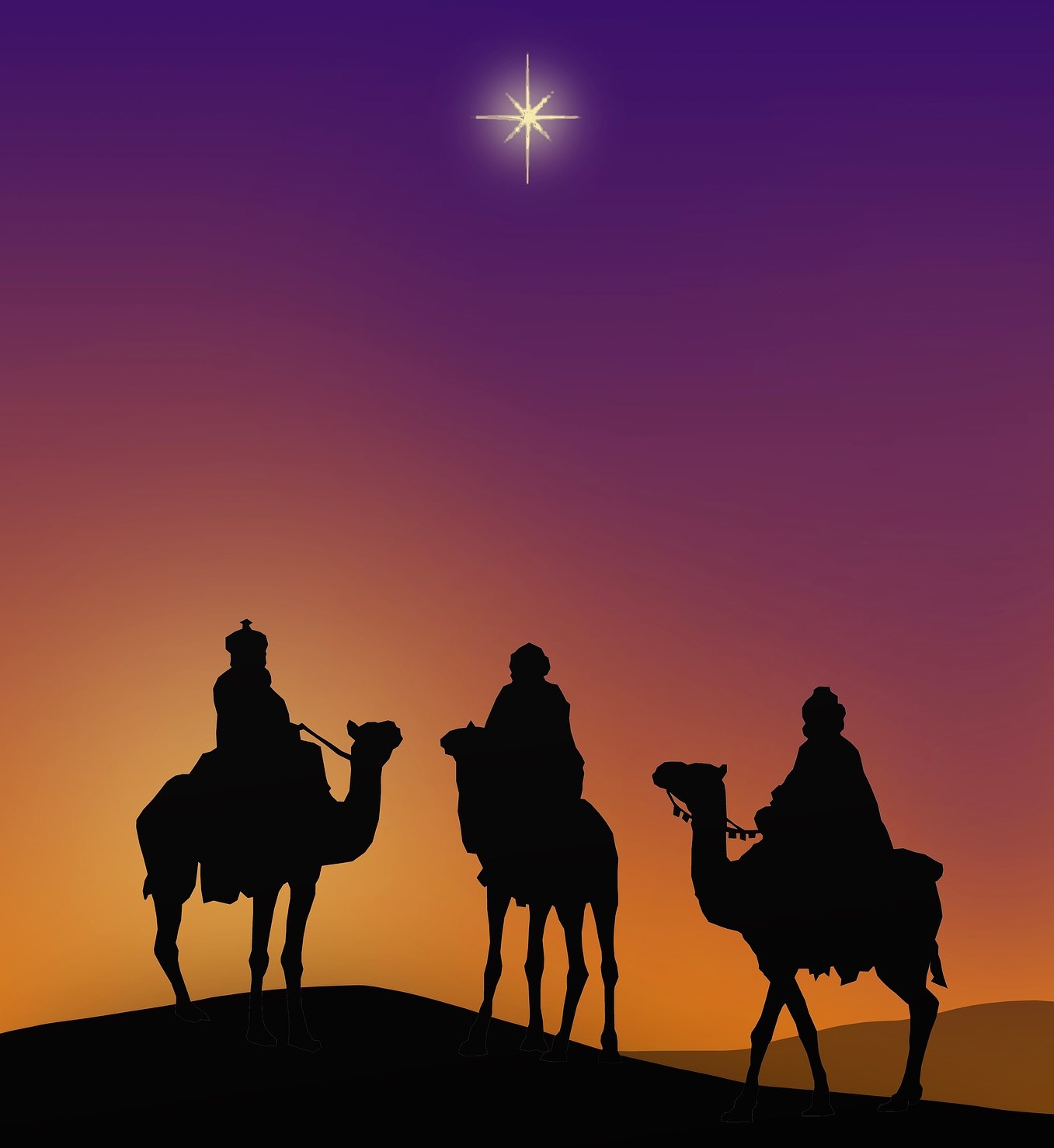 The Magi, celebrated on Three Kings Day in Croatia
The Magi, celebrated on Three Kings Day in Croatia
If you've seen a nativity scene or any Christian art related to Christmas, you'll be familiar with the image of the Three Kings. But, actually, they are not in the Bible. What the Bible says is, Magi arrive in Jerusalem at the time of Jesus's birth. They ask the location of the 'king of the Jews' so they can pay tribute. No number is allocated to the Magi.
However, the Bible details that the Magi carry with them three gifts for Jesus – frankincense, gold and myrrh. It is from this number of gifts that the embellished western tradition presumes the number of Magi. In the eastern church, the number of Magi is actually set at 12!
Their number is not the only way their story has been enhanced. Over the years, the Magi have been given very different places of origin. In some of the first embellishments, the kings are said to represent lands of Arabia, Persia and India. But, as Christianity spread, the story changed – perhaps to be either more inclusive or reflect self-importance. Later versions have the kings representing Asia, Africa and Europe. The Bible actually says all three arrive from the east (Africa and Europe are obviously not east of Judea.)
From the 8th century we find the first evidence of the Three Kings being given names - Balthasar, Melchior, and Gaspar (or Casper). In the Bible, the Magi follow a star to reach Jerusalem at the time of Jesus birth. But, they stop and ask directions. Three Kings Day is when they finally arrive to pay tribute to Jesus.
In our celebration of Christmas, this is 12 days after the birth of Jesus Christ. And yet, in every nativity and Christmas painting, shepherds attend the scene immediately after Jesus's birth, closely followed by the Three Kings. To understand what is happening with the Three Kings and the Epiphany you need to look at the Gospel according to Matthew.
Understanding the Gospel according to Matthew
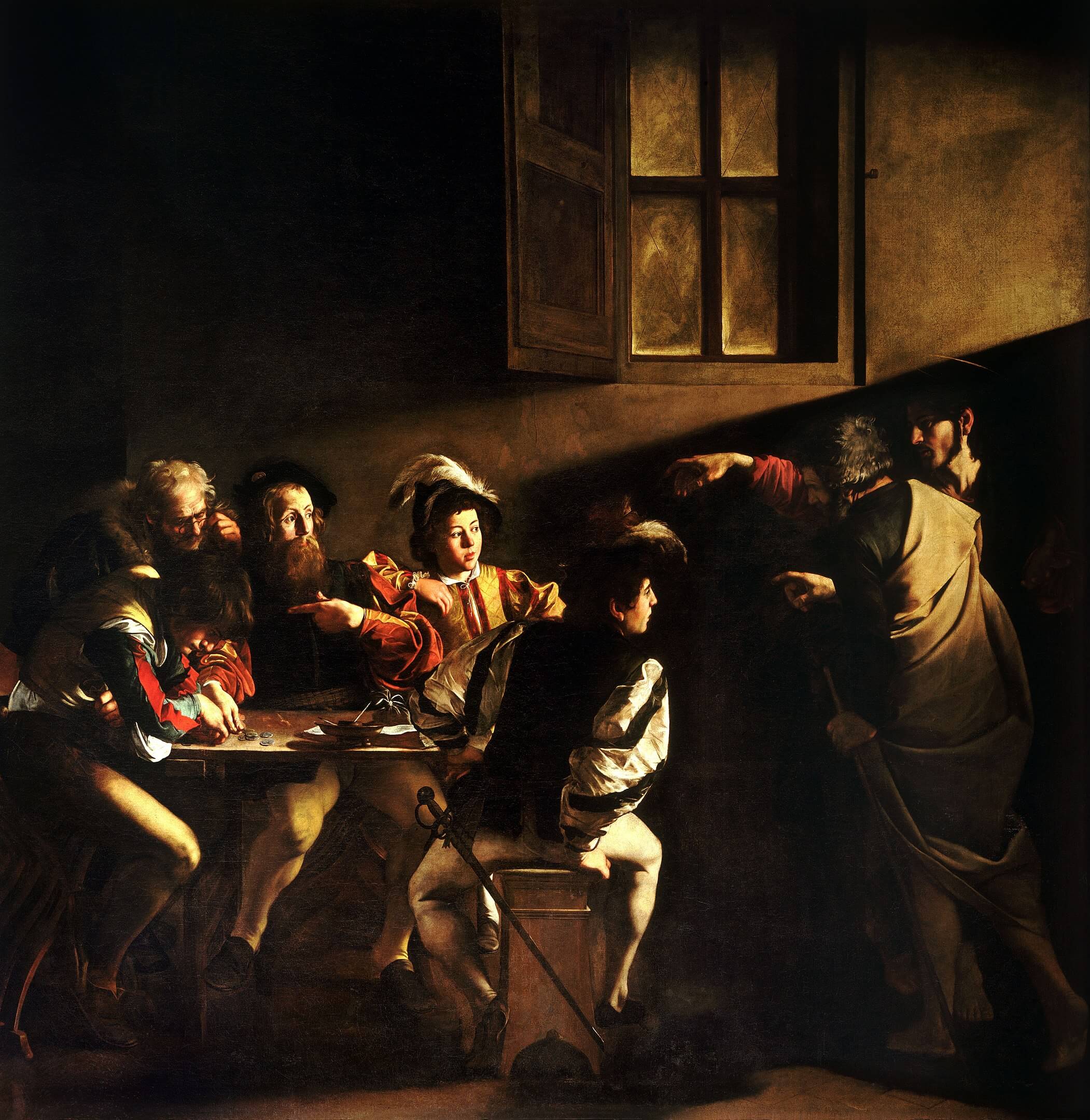 The Calling of St Matthew by Caravaggio
The Calling of St Matthew by Caravaggio
The first three books of the New Testament are Matthew, Mark and Luke. When originally written, they were not intended to be placed next to each other in a single compiled 'book'. And so, within the first three books of the New Testament, we find quite a lot of repetition, as each of these disciples recounts the life and story of Jesus.
The Gospel according to Matthew is arguably the most famous and most detailed of these books. As an example, it is the only book where we are told about the Magi visiting Jerusalem and Jesus. It is also the most Jewish of the Gospels - in structure and in language (it is originally written in Greek).
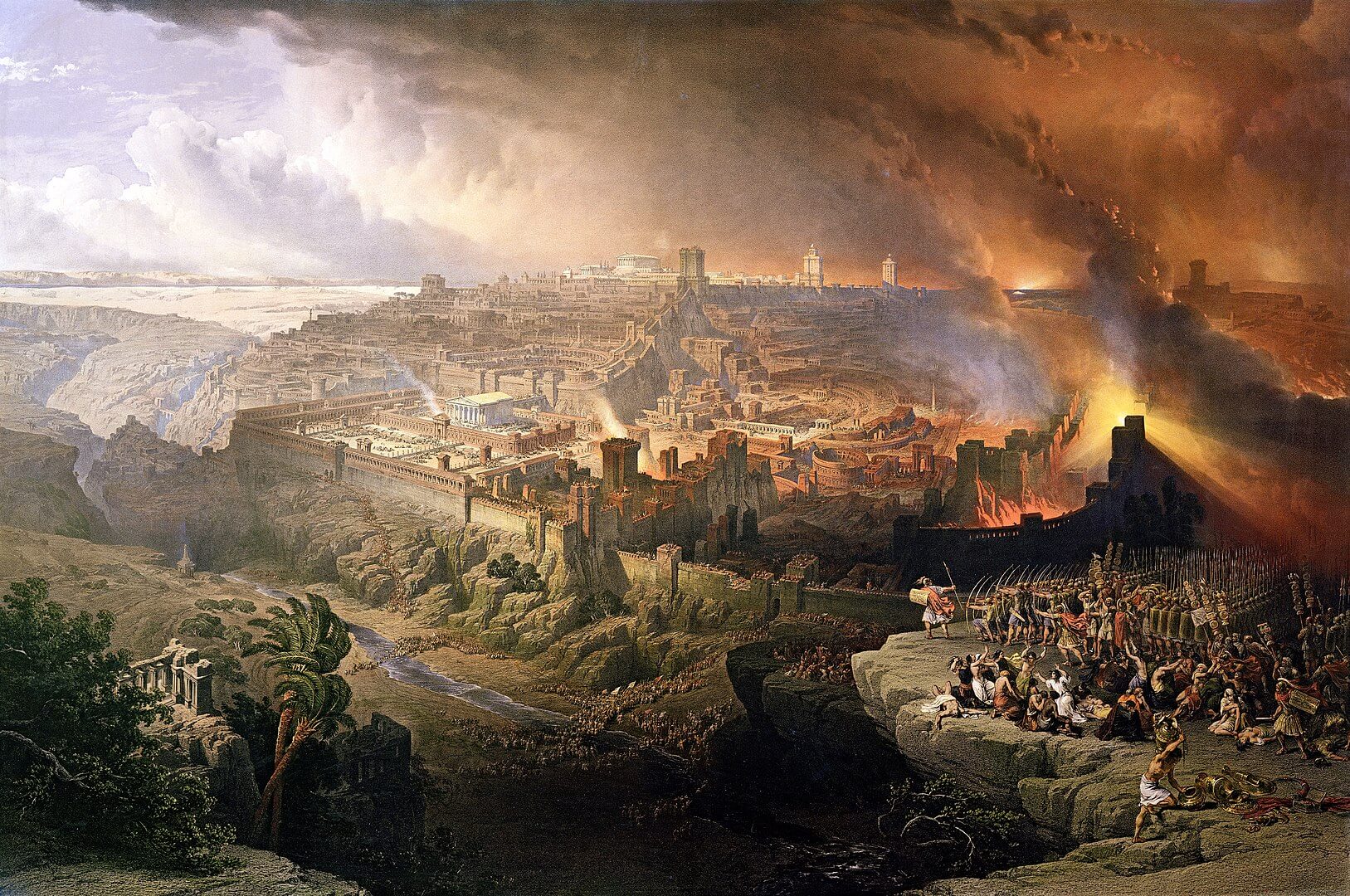 The Siege and Destruction of Jerusalem by the Romans Under the Command of Titus, by David Roberts
The Siege and Destruction of Jerusalem by the Romans Under the Command of Titus, by David Roberts
The books of both Luke and Matthew take from the book of Mark, which is widely considered to have been written first. Most scholars today agree that Matthew was written sometime between AD70 and AD100, not by Matthew himself, but by his followers. If accurately dated, the book is written within recent memory of the destruction of Jerusalem and its Jewish temple by the Romans in AD70.
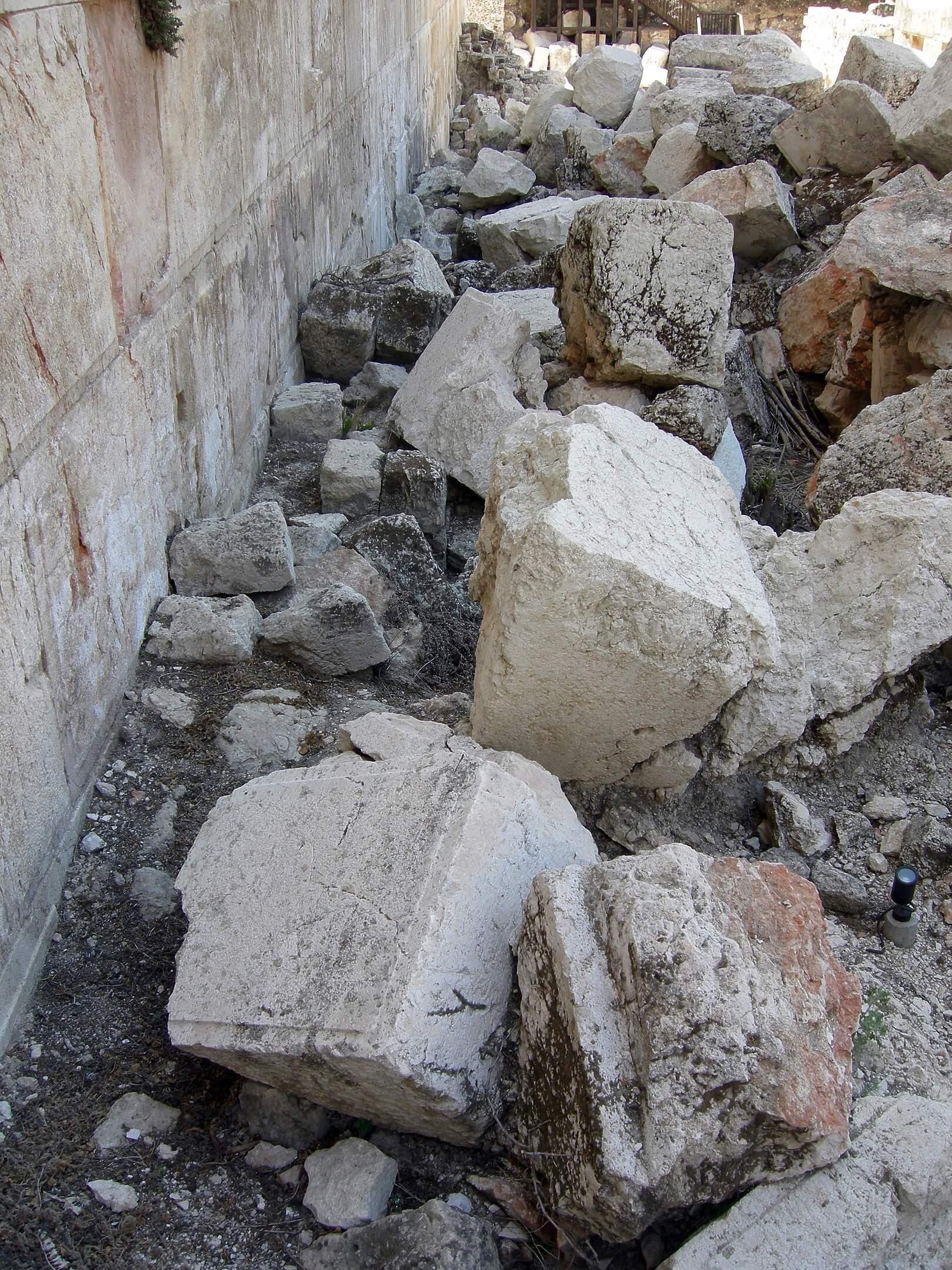 Stones from the Western Wall of the Temple Mount (Jerusalem) thrown onto the street by Roman soldiers in AD70
Stones from the Western Wall of the Temple Mount (Jerusalem) thrown onto the street by Roman soldiers in AD70
In the lifetime of Jesus, His ministry was limited to the land of Judea. Thereafter, the ministry of Matthew was similarly aimed towards Jews. The Gospel according to Matthew begins by carefully detailing Jesus as a descendant of David and Abraham. This is necessary in order for Jesus to be the Messiah spoken of in Jewish prophecy.
Several times in the gospel, Matthew is critical of Jewish Pharisees. But, he is not trying to replace Judaism with a new religion. Instead, he says Jesus is fulfilling Jewish prophecy. He instructs that Jewish scriptures should be more closely adhered to by the followers of Jesus (than they had been by 'hypocritical' Pharisees).
And yet, at the time it was written, a certain separation must have existed between Matthew's followers and many Jews simply because Matthew's followers insisted Jesus was the Messiah. The Gospel ends with the resurrected Jesus instructing “go and make disciples of all the nations". Therefore, Matthew pre-empts the spread of the faith and stands as a bridge between Judaism and the new church. No doubt, this is part of the reason Matthew is the first book of the New Testament instead of the earlier Gospel of Mark.
That the kings come to pay tribute to Jesus in Matthew further fulfils Jewish messianic prophecy. It also positions Jesus as the Son of God for gentiles (non-Jews).
Blagoslov obitelji (family blessing) and the traditions of Epiphany (Bogojavljenje) Three Kings Day in Croatia (Sveta tri kralja)
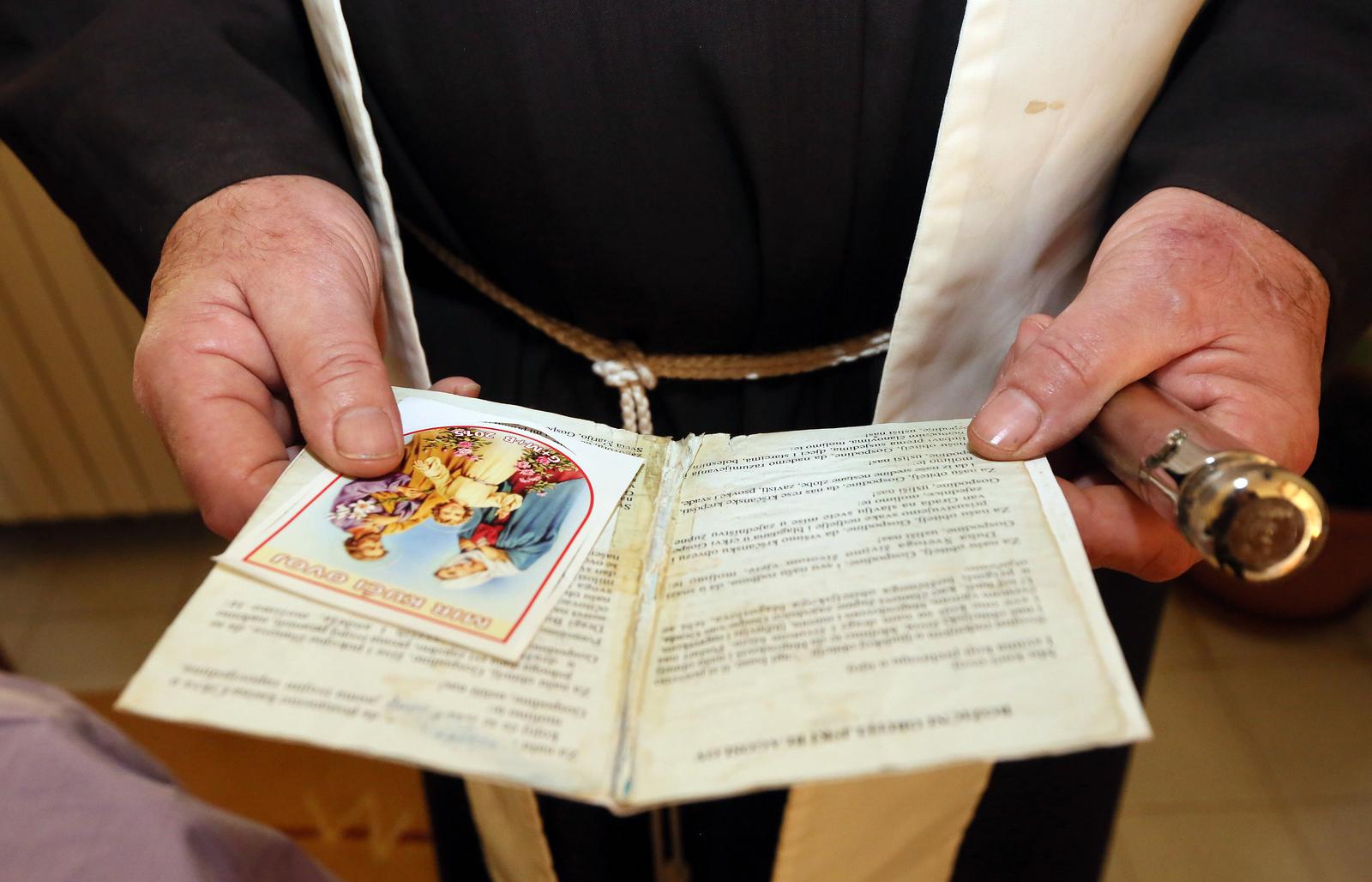 Bogojavljenje aka Three Kings Day in Croatia, by Dusko JaramazPIXSELL
Bogojavljenje aka Three Kings Day in Croatia, by Dusko JaramazPIXSELL
Traditionally, this is the day on which your local priest would visit your home to bless it and the family within. Nowadays, Croatia's population has grown so as to make this impossible. So, in the modern era, the annual blessing of home and family take place between St. Stephen's day (here) and today.
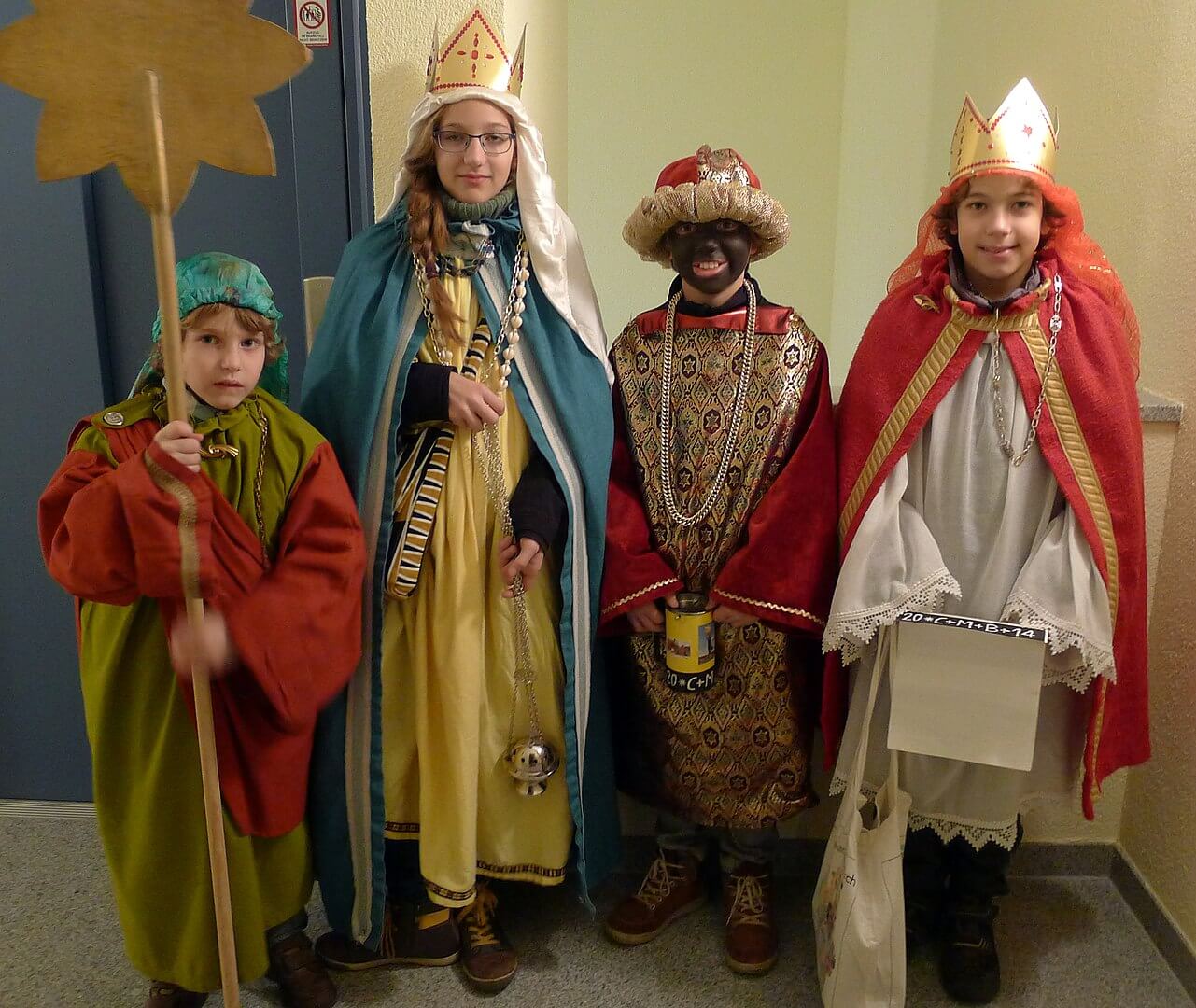 Zvjezdari in Germany, by James Steakley
Zvjezdari in Germany, by James Steakley
This is still a day of Christmas, celebration and decoration. Traditionally, the priest may have been accompanied by altar boys who rang bells to let villagers know they were on their way. These days, the altar boys could be choristers or simply young parishioners. It is not uncommon for them to sing and to be dressed as the Three Kings and carrying a star (Zvjezdari – starmen).
 Collection of stickers marking Blagoslov obitelji (family blessing), awarded on Three Kings Day in Croatia. Note the different spelling of Saint Gaspar (Croatian) / Caspar (Latin)
Collection of stickers marking Blagoslov obitelji (family blessing), awarded on Three Kings Day in Croatia. Note the different spelling of Saint Gaspar (Croatian) / Caspar (Latin)
As part of the home blessing, it was traditional for the priest to sprinkle the home with Holy water. Also, he would write in chalk above the main entrance to the home. The chalked pattern would read 20 ✝ C ✝ M ✝ B ✝ 22 - numbers denoting the year, and the cross separating the letters C (G), M and B. These are the initials of the Magi Caspar (Gaspar), Melchior and Balthazar. They are also an abbreviation of the Latin blessing Christus mansionem benedicat - May Christ bless this house. This chalking of the door signals the home has been blessed for the year and echoes the Old Testament marking of doorways by the Israelites in Egypt. As in Matthew, the tradition of Three Kings bridges Judaism and the new church. Nowadays, the chalk writing has in most instances been replaced by stickers.
 Collection of stickers marking Blagoslov obitelji (family blessing) - these will be added to on Three Kings Day in Croatia
Collection of stickers marking Blagoslov obitelji (family blessing) - these will be added to on Three Kings Day in Croatia
In the distant past of Three Kings visits, a greater significance was put on the blessing of the home and property. But, in order to diminish the supernatural aspect of 'warding off bad spirits from the home', the church has continuously aimed to make the blessing more about the family gathered within. These days, that is reflected in the contemporary wording of the blessing.
This family aspect of the blessing actually goes back an incredibly long way. This time of year is one of the least demanding for those who work in farming or agriculture. It was easier to gather together the full family for the blessing at this time than at almost any other during the year. This tradition still exists – it is customary for the full family to be gathered together when the priest visits.
Another tradition that persists is the cleaning of the home prior to the visit. Although, this is not only because the priest is coming. Remember, Bogojavljenje is Jesus's revelation as the Son of God to all those outside Judea and Judaism – as represented by the Three Kings.
The Three Kings give the gifts of frankincense (signifying his origin from God), gold (signifying his royal status on earth) and myrrh (a balm, signifying that Jesus is a man). The cleaning and blessing of the home welcomes Jesus into Croatian home – as a man he walks among us.
In the modern era, it is customary for the family to give a monetary donation to the priest at the time of the visit. This is not traditional nor is it 'payment' for the blessing or visit. God's blessing cannot be bought or paid for, and is not denied to anyone who asks for it - whether he had money or not. That the traditional annual donation takes place on this visit is a matter of convenience.
Non-Croatian traditions of Epiphany (Bogojavljenje) Three Kings Day in Croatia (Sveta tri kralja)
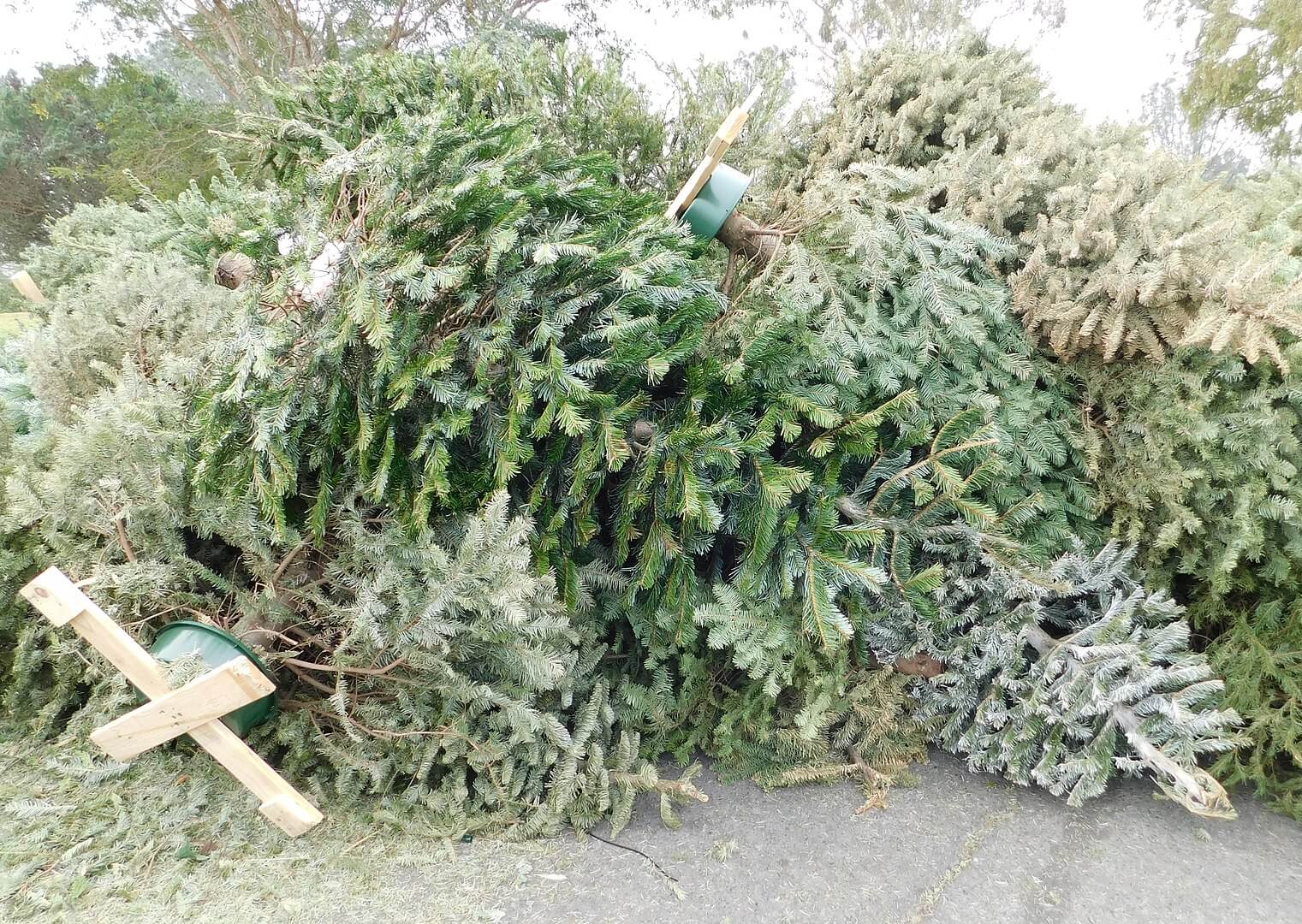 Christmas tree recycling, by Ruff tuff cream puff
Christmas tree recycling, by Ruff tuff cream puff
Bogojavljenje is one of the oldest Christian holidays marked in the Croatian Catholic calendar. The fact the day remains a national holiday in Croatia attests to its continued importance.
The laziest and most incorrect contemporary 'custom' attributed Croatian Bogojavljenje is that it's the day you should throw out your Christmas tree and take down your decorations. Wrong. The second biggest modern error is to regard Bogojavljenje as the end of Christmas.
The Christmas tree is not a traditional part of Croatian Christmas. It is German. Its widespread popularity only really began from around 1850 in the UK (thanks to their German monarchy importing it) and from 1870 in the USA. Only after that did the custom travel internationally. To regard the discarding of Christmas trees as a fundamental part of a centuries-old tradition displays an extremely limited and shallow knowledge of Croatian traditions.
In fact, it is Croatian tradition for the local priest to visit the family with the home still decorated. Typically, the priest was fully embraced into the family Christmas setting when he called – jaslice (nativity), candles, log fire, decorations and all. In the past, the priest was usually offered food and drink from the family. In many instances, they would all enjoy the seasonal food together.
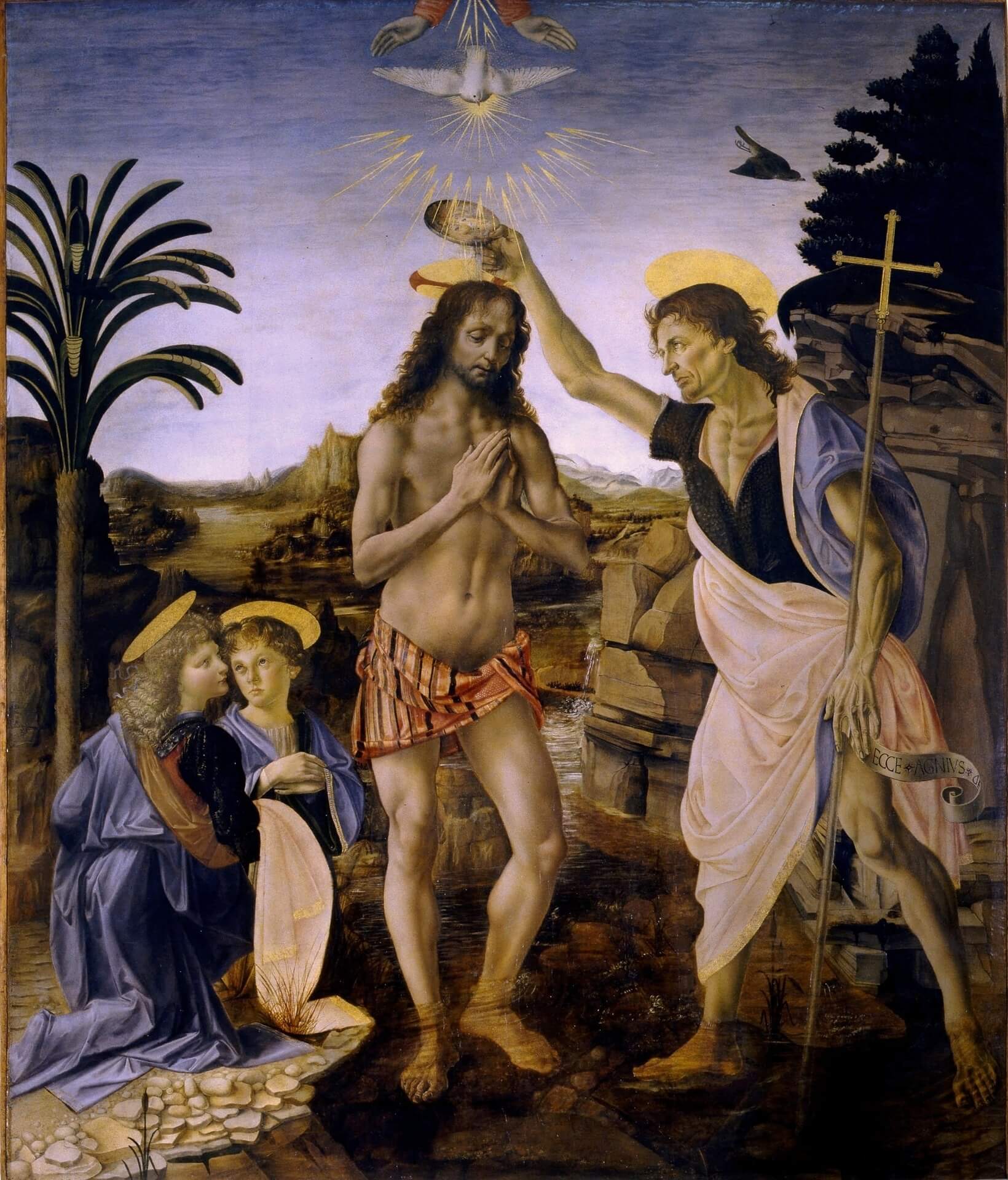 Baptism of Christ, by Leonardo DaVinci
Baptism of Christ, by Leonardo DaVinci
Advent starts on the fourth Sunday before Christmas and ends on Christmas Eve (here). Christmas begins in the evening of Christmas Eve. Like elsewhere, Epiphanytide begins on Three Kings Day in Croatia. But, that does not mark the end of Christmas. In fact for Catholics, Christmas ends officially on the Feast of the Baptism of the Lord, celebrated on the Sunday after Epiphany - Three Kings Day in Croatia (in 2022, Sunday 9 January).
Accordingly, the most traditional of Catholic houses and churches in Croatia can be seen displaying their decorations until then. Three Kings does mark the end of the '12 Days of Christmas', but this is a secular duration of Christmas and has little to do with Croatian tradition.
With grateful thanks to Iris Ćelić, family Kutleša / Marinić, Pater Ivan Dominik Ilicic and Marko Čurković
Workers’ Front Activists Call for Cancellation of Vatican Agreements
ZAGREB, 18 Dec, 2021 - Activists of the Workers' Front party on Saturday addressed reporters outside the Sisak General Hospital, by a newly installed sculpture representing Virgin Mary and Child Jesus, calling for the termination of agreements between Croatia and the Vatican.
The sculpture, installed outside the entrance to the new hospital block in early December, was a gift to the hospital by the Sisak Diocese.
Workers' Front activist David Bilić said the sculpture "is a tasteless expression of the wealth of the Catholic Church outside an earthquake-damaged hospital that has still not been reconstructed."
"The Workers' Front believes too much money is set aside for the Roman Catholic Church in Croatia, as a result of the Vatican agreements, signed on this day 25 years ago," Bilić said, adding that the party believed the Vatican agreements should be cancelled.
He said that the situation in society had changed due to the economic crisis that was even more felt in the earthquake-struck Sisak-Moslavina County.
The coronavirus pandemic is making the situation worse, not to speak of earthquake damage, while work on removing it is not starting, he said.
"Some will say that the Catholic Church justifies the donations through its charity work," Bilić said, noting that 11% of that money is used for charity work.
"The rest is used for other needs of the Church, which can secure quite a sufficient amount of money for its financing from alms and Vatican sources," Bilić said, with RF activists calling for the reconstruction of the earthquake-hit county to begin as soon as possible.
For more on lifestyle, follow TCN's dedicated page.
For more about Croatia, CLICK HERE.
Largest Church Mosaic in Croatia Unveiled in Karlovac
November 13, 2021 – After many years of preparation and effort, the largest church mosaic in Croatia has been revealed to parishioners at the Church of Saint Joseph (Crkva sv. Josip) in Karlovac
The beautiful mosaic covers an incredible 120 square metres of wall behind the church's altar. Depicted in the mosaic is the birth of Jesus Christ.
The mosaic is the work of renowned Croatian artist Josip Botteri Dini who is based in Split. On 1st January 2021, Mr Josip Botteri Dini and several assistants began stacking coloured glass pieces into one-square-metre templates to construct the work.
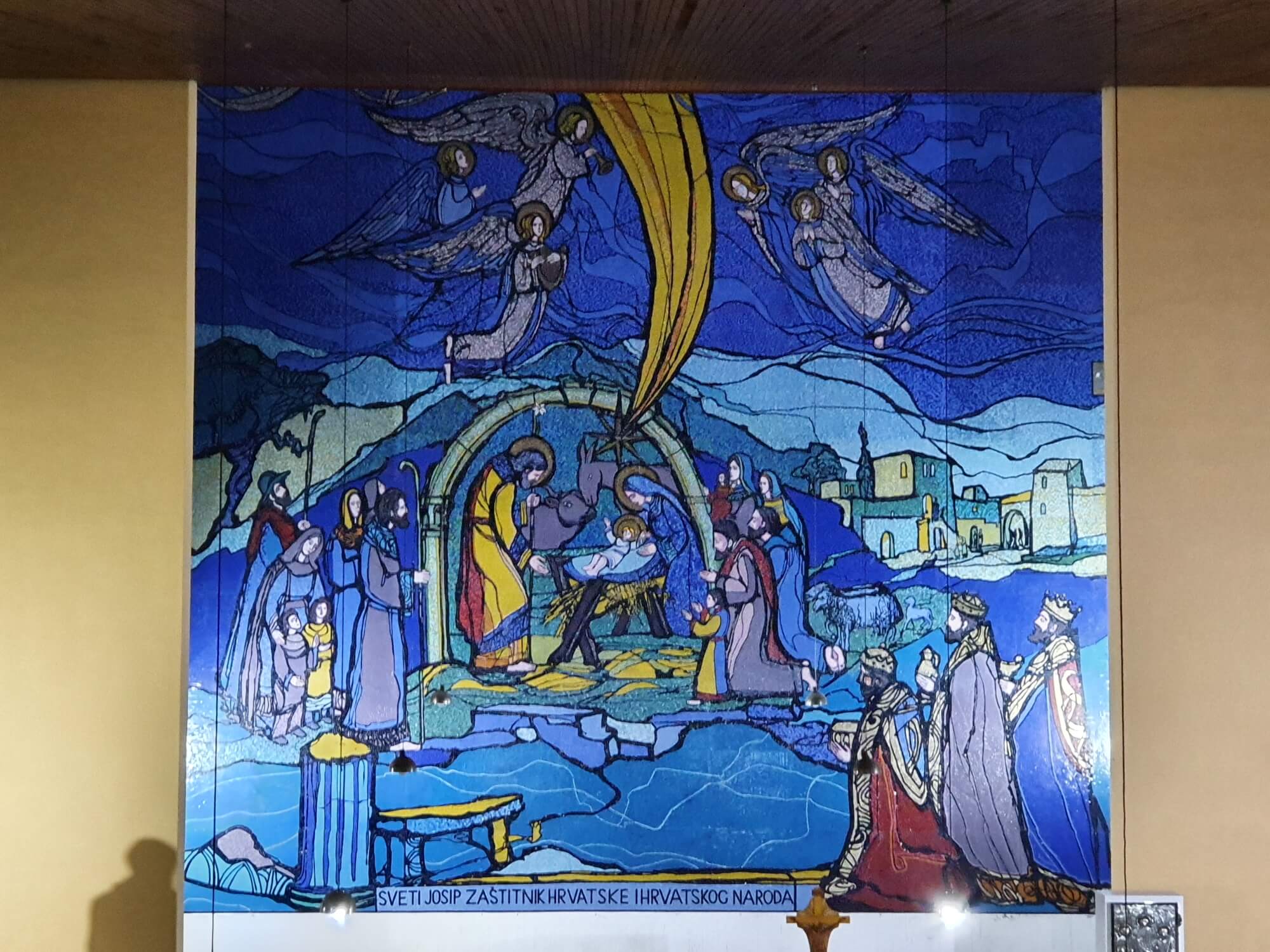 Largest Church Mosaic in Croatia © Marina Buric / Visit Karlovac
Largest Church Mosaic in Croatia © Marina Buric / Visit Karlovac
Each template contains around 2500 mosaic parts. In total, the mosaic has around half a million pieces of coloured glass. It took Mr. Botteri Dini nine months to finish stacking 168 templates. After completing that long section of the task in Split, he then travelled to Karlovac and continued working there. The installation of the templates onto the wall took two weeks. Subsequently, six weeks of cleaning and aligning of the mosaic followed.
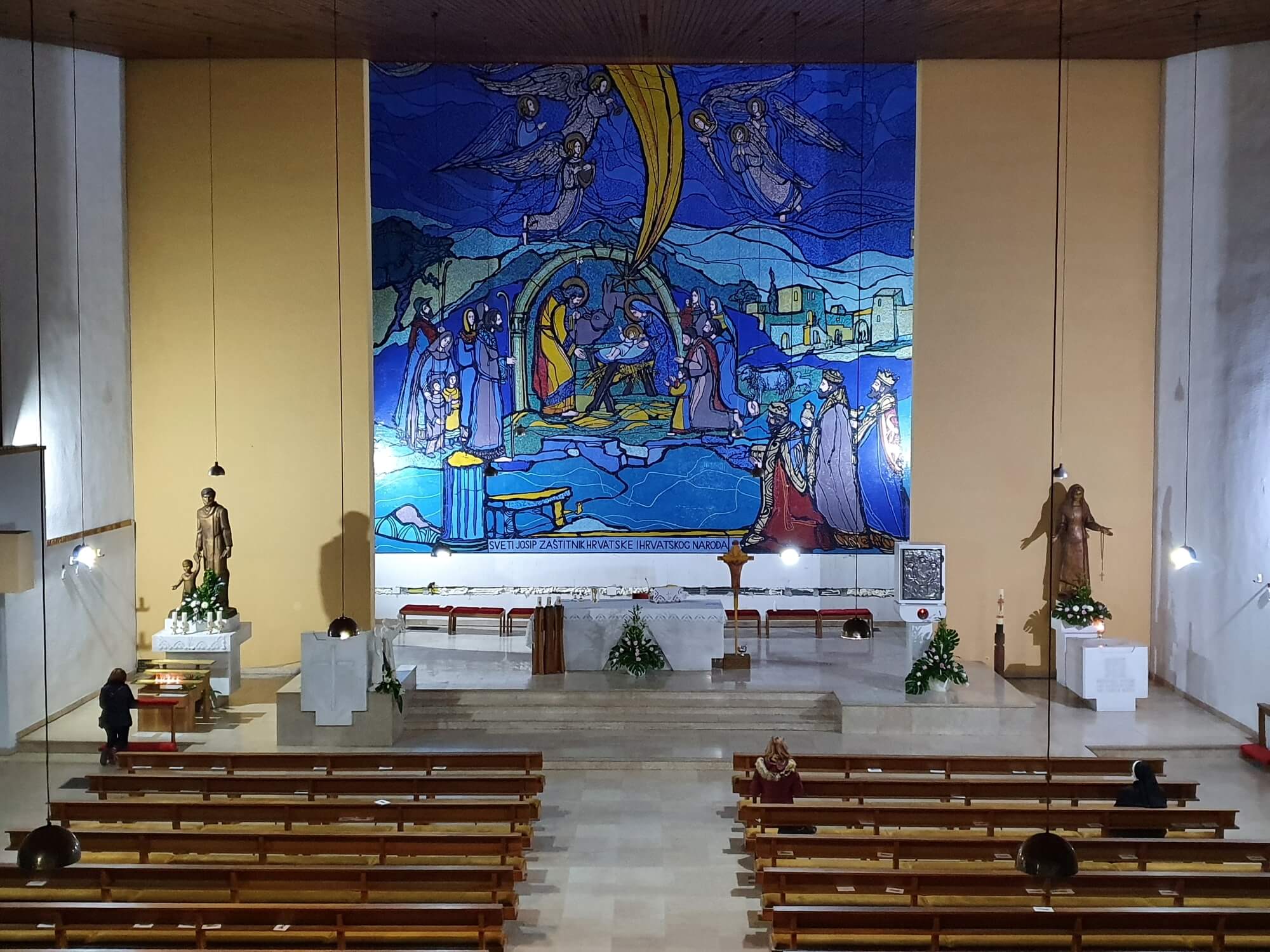 From the rear of St. Josip's Church © Marina Buric / Visit Karlovac
From the rear of St. Josip's Church © Marina Buric / Visit Karlovac
Josip Botteri Dini, the artist behind the largest church mosaic in Croatia
Although he now lives and works in Split, Josip Botteri Dini was actually born in Zagreb in 1943. He studied at the city's Academy of Fine Arts, notably in the class of famous Varaždin painter and graphic artist Miljenko Stančić. Josip graduated in 1968. Since the early 1970s, the work of Josip Botteri Dini has been exhibited over a hundred times throughout Croatia and overseas. In addition to painting, he works with mosaics and stained glass.
 In detail, Croatia's largest church mosaic, in St. Josip's, Karlovac © Marina Buric / Visit Karlovac
In detail, Croatia's largest church mosaic, in St. Josip's, Karlovac © Marina Buric / Visit Karlovac
Being the largest Church mosaic in Croatia, it was necessary to construct a 13-metre high scaffold for the work to be set on the church wall. Although Mr. Botteri Dini is now 78 years old, he climbed the scaffold every day to finish his work, helped by his brothers Juraj and Dezi. They are also in their seventies.
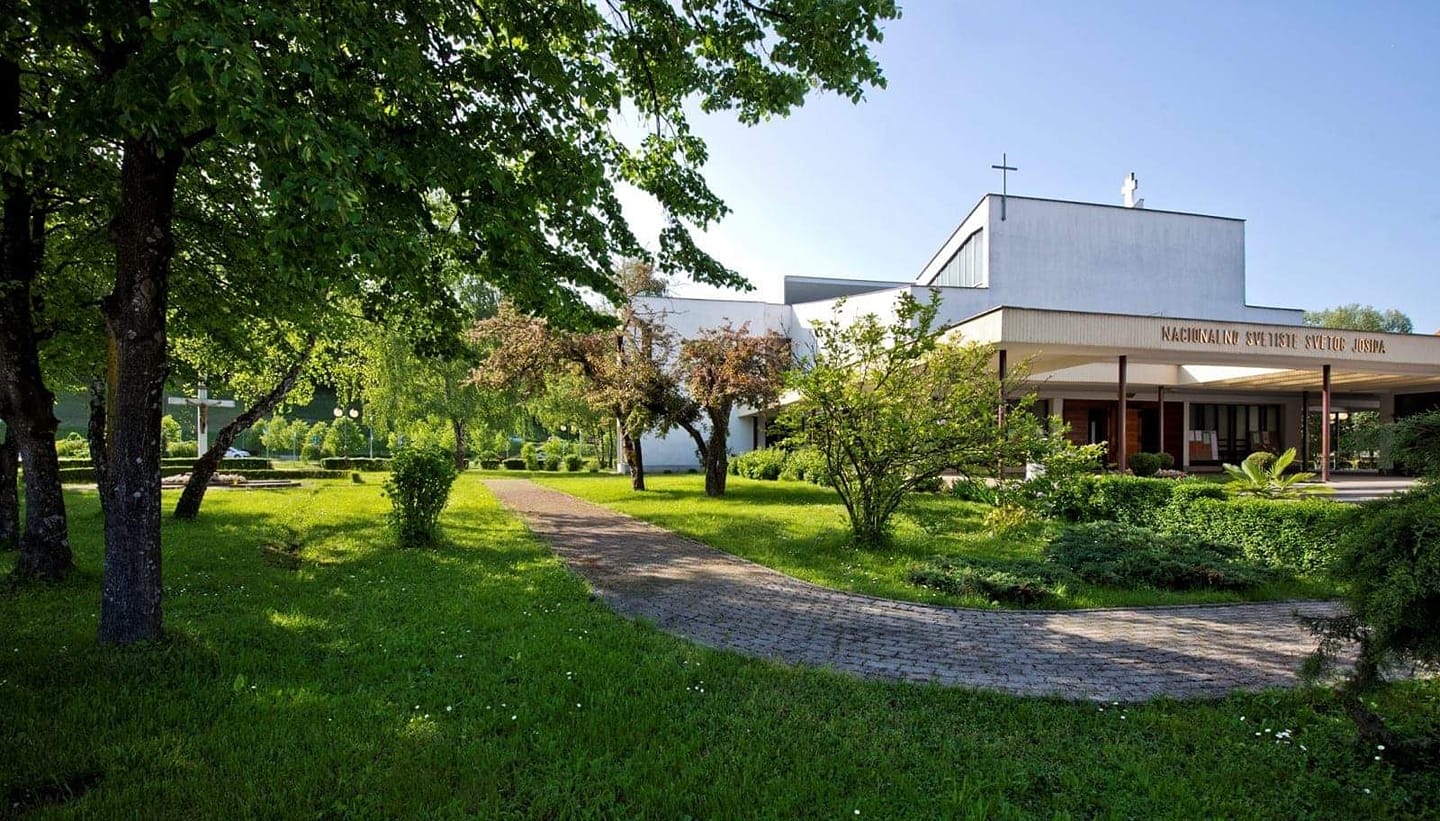 Nacionalno svetište svetog Josipa (National Shrine of St. Joseph) in Dubovac, Karlovac
Nacionalno svetište svetog Josipa (National Shrine of St. Joseph) in Dubovac, Karlovac
Nacionalno svetište svetog Josipa (National Shrine of St. Joseph) in Dubovac, Karlovac
Otherwise known as Nacionalno svetište svetog Josipa (National Shrine of St. Joseph), the modern Church of Saint Joseph lies to the west of Karlovac city centre in Dubovac. In fact, it sits at the foot of the hill on which is placed the 13th-century castle fortress Old Town of Dubovac, from where the settlement gets its name.
Construction of the Church of St. Josip started in 1968 but its external facades were not completed until 1972. In 1975 its bell tower was built although it would take until 1980 for three new bells to be placed within it. In 1987, the church was dedicated as a national shrine for Saint Joseph, marking the 300th anniversary of Saint Joseph being assigned as Protector of the Homeland and the Croatian people. Saint Joseph is also the patron saint of Karlovac.
The largest Church mosaic in Croatia is not the only masterpiece to be found in the Church of St. Josip. Within the building is the permanent exhibition space Galeriji 'Martin Borković'. It contains works of art by 28 eminent Croatian painters and sculptors. You can see them every day after Holy Mass.
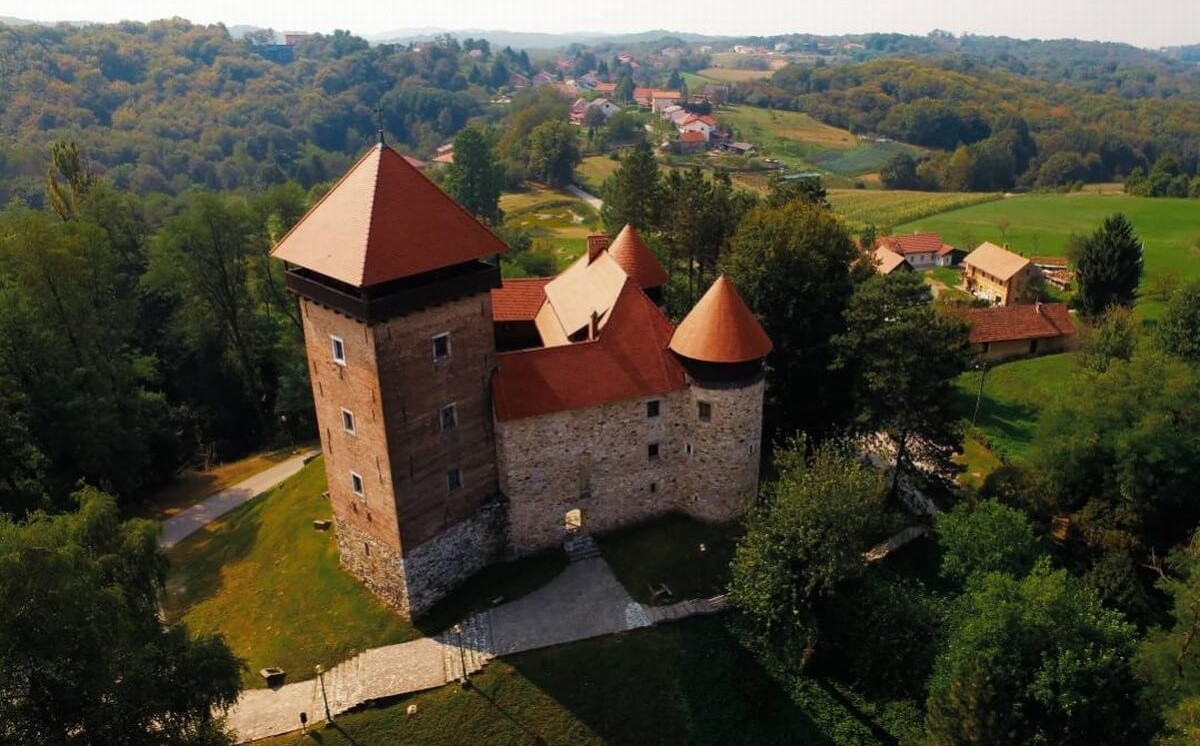 The Old Town of Dubovac © Ivo Biočina
The Old Town of Dubovac © Ivo Biočina
The Old Town of Dubovac is one of the best-preserved buildings of its kind in Croatia. A popular tourist attraction, it hosts events and has one of the city's best restaurants on the ground floor of its atmospheric courtyard. With the addition of the largest Church mosaic in Croatia, visitors now have another excellent reason to stop off in the quiet Karlovac suburb of Dubovac.
You can read more about Karlovac in the Total Croatia guide to the city here. For the latest news about Karlovac, be sure to check Total Croatia News tagged pages here
Experts at Catholic Social Week Warn About Croatia’s Demographic Crisis
ZAGREB, 24 Oct, 2021- The Sixth Croatian Social Week, which was organised by the Catholic Church in the country, on Saturday adopted a declaration which underscores that Croatia is in a deep demographic crisis and calls on the authorities to take measures to halt negative trends.
The declaration, adopted at the end of the event that brought together about 200 participants, warns about a demographic failure in Croatia due to the intensive decrease in the number of newborns and demographic ageing.
The document says that the country lacks a long-term strategy and a supra-party policy to address the issue.
The declaration recommends that the population strategies should encompass pro-natalist and moderate migration policies.
The participants in the event concluded that in the future Croatia would have to cope to a greater extent with the issues regarding migrations.
They also call for more attention to be paid to expats coming back to Croatia.
For more on lifestyle, follow TCN's dedicated page.
For more about Croatia, CLICK HERE.
Archbishop of Zagreb Says Song of Mary Applies to All
ZAGREB, 15 Aug, 2021 - The Archbishop of Zagreb, Cardinal Josip Bozanić, said on Sunday the task stemming from the Magnificat, the Song of Mary, applied to every individual and the entire people, "starting from those who carry responsibility in the Church, political and social areas."
Speaking at the central Mass on the occasion of the Assumption in the Marija Bistrica Marian shrine, he said, among other things, that the ongoing pandemic showed that strong civil friendship and unity were necessary and that people were responsible for one another.
"That's why today we pray for all those ill with coronavirus as well as those caring for them, notably the medical staff."
The cardinal also said the Feast of the Assumption led to a better understanding that every conception and birth of a human being was a gift to the mother, the family and the community.
Among those attending the service were Veterans Minister Tomo Medved and Physical Planning, Construction and State Assets Minister Darko Horvat.
Today is also the 50th anniversary of the declaration of Marija Bistrica as the Croatian National Marian Shrine.
For more on lifestyle, follow TCN's dedicated page.
For more about Croatia, CLICK HERE.
Ivo Pilar Social Research Institute Expanding Scientific Cooperation in Sarajevo (BiH)
July 2, 2021 - Dedication to researching and developing the field of social sciences sees the Ivo Pilar Social Research Institute expanding scientific cooperation once again after Željko Holjevac's visit to Sarajevo, in Bosnia and Herzegovina.
The Ivo Pilar Social Research Institute, active as always, continues to expand its cooperation on scientifically explain social issues (symbolically noted as 2021 marks 30 years of the Institute).
As reported on their official website, Institute headmaster dr. Željko Holjevac visited Sarajevo, the capital city of the neighboring Bosnia and Herzegovina, from June 21-23.
The main story of that visit was a signed bilateral cooperation agreement between the Ivo Pilar Social Research Institute and the Sarajevo Catholic Faculty. The agreement was signed by Holjevac and Faculty dean dr. Darko Tomašević.
Additionally, Holjevac was at the reception with Vrhbosanski's vice bishop Vinko Puljić.
„They talked about possible shared projects that would be adjusted to the tradition, culture and developing needs of Croats in Bosnia and Herzegovina“, informed Ivo pilar social research Institute.
Croatian Cultural Society Napredak (progress) also met with Holjevac. Napredak soon celebrates 120 years of work and was founded at the start of the 20th century when the famous Croatian social scientist Pilar was active in Bosnia and Herzegovina. Napredak plans various manifestations for their big anniversary, and dr. Holjevac discussed the possible cooperation in organizing an international scientific symposium regarding the identity of Croats in Bosnia and Herzegovina.
Ivo Pilar Institute working in full speed
This sort of cooperation in regards to researching the Croatian diaspora in the neighboring country where the Croatian historical role and present is significant is nothing new for the Ivo Pilar Social research Institute.
As TCN reported earlier in May, the Institute, along with scientific partners, organized a conference “Identity of Boka Kotorska Croatians“, and the three-day event gathered crucial scientific institutes in Croatia to the town of Tivat in the Bay of Croatian Saints in Montenegro.
Scientists from the Institute were also active this year as they participated at European Conference For Social Work Research (ECSWR), International Society for Ethnology and Folklore (SIEF) Conference, and also by presenting a book on Croatian Mountain Rescue Service in Gospić, or by presenting book Cultural Identity of Vukovar – Contribution to Investigating Heritage and Successors“ – to list some of the activities TCN reported on throughout 2021.
As 2021 marks the 30th year anniversary of the Ivo Pilar Institute, apart from the aforementioned actions (to which we can include nurturing relations with scientific colleagues in Slovakia or opening a new research office on Vis Island), several more goals were envisioned by the end of the year: to publish the first edition of critical translation for the book „South Slavic (Yugoslav) Question“ by Ivo Pilar from 1918, and to make and publish Pilar's Kaleidoskop of Croatian society.
With the active academic dynamic demonstrated by the Institute, there is no doubt there is enough quality and capacity to achieve these goals. It is only a matter of time in such a busy and productive schedule.
Learn more about Croatian Diaspora on our TC page.
For more about science in Croatia, follow TCN's dedicated page.
Nedelisce Parishioners Forgive Priest After He Leaves Church For Love
November 8, 2020 - Nedelisce parishioners are seemingly universal in their understanding and forgiveness as their local pastor leaves the priesthood for an altogether different kind of calling
Not every job is undertaken just to pay the bills. The strong urge to take a specific career is often referred to as a calling. Occupations in which you help other people are usually those described in this way - doctors, teachers, nurses, nuns and priests.
Spoken of with admiration, those who receive 'a calling' are presumed to be on a path of life which is their true destiny. Be it supernatural, genetically implanted or influenced by God, it is considered unlikely that anything could turn their heads and make them veer off course. Such considerations are naïve in their ignorance of Cupid's arrow.
Both Vecernji List and 24 Sata this week reported on the recent resignation of popular parish priest Rev. Tihomir Ciglar (30). Although on his path to the priesthood since he attended Archbishop's Classical Gymnasium in Zagreb, Ciglar has recently departed from his chosen course in favour of an altogether different calling - he fell in love.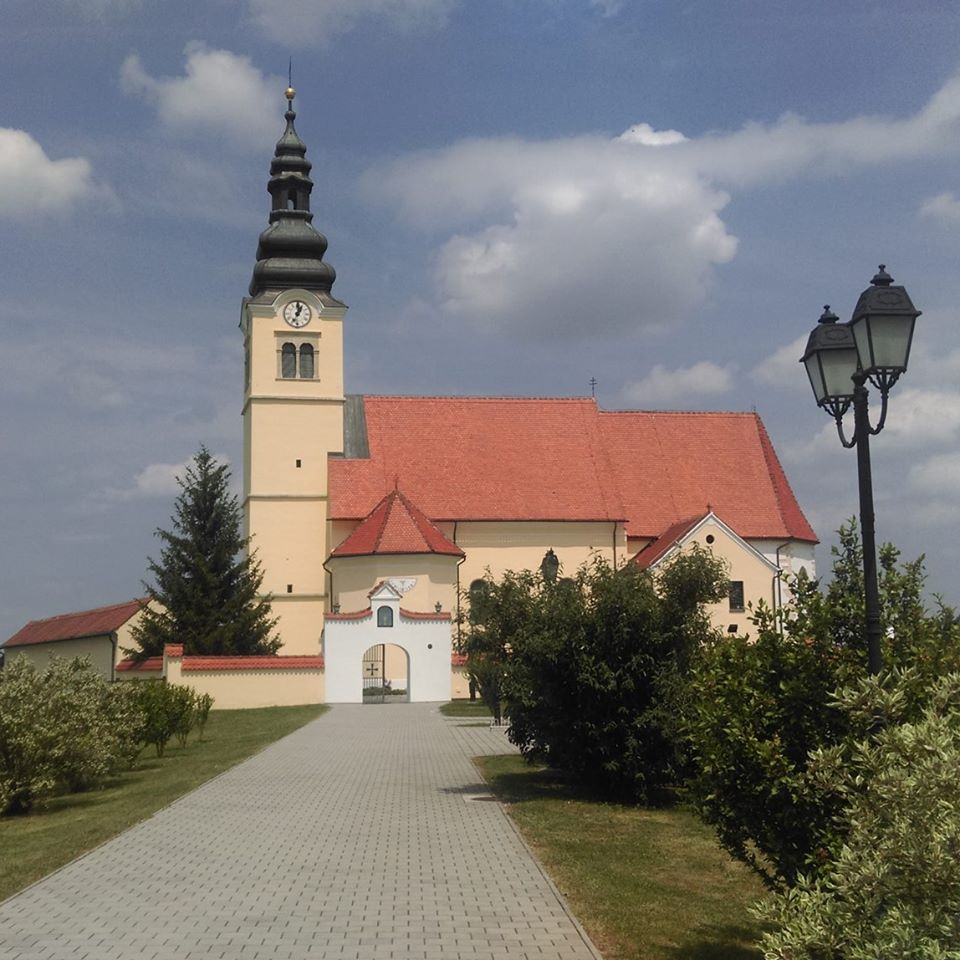 The parish church in Nedelišće © Župa Presvetog Trojstva - Nedelišće
The parish church in Nedelišće © Župa Presvetog Trojstva - Nedelišće
“He was wonderful.,” one of Ciglar's former Nedelisce parishioners is quoted as saying in 24 Sata. Nedelišće is a small town near Varaždin. “He was mild-mannered, good, everyone's favourite. My whole family loved going to Mass and listening to the sermons because of him. And then what happened, happened. He just fell in love, that's how it was.”
“We don't blame him for anything,” the parishioner continued, her voice apparently representative of locals' general feeling on the affair of the popular priest. She also added that news was circulating about the imminent arrival of the couple's first child. “May God give them many more children!”
Tihomir Ciglar was first presented to Nedelisce parishioners in 2014 as a chaplain, and in 2018 he was appointed pastor of the church. His pull from the pulpit occurred after he met the woman who is now his girlfriend in service of the church – she donated her time in the form of a cook. Further speculation on the development of feelings between the woman and her roamin Catholic partner is perhaps best left for village gossip.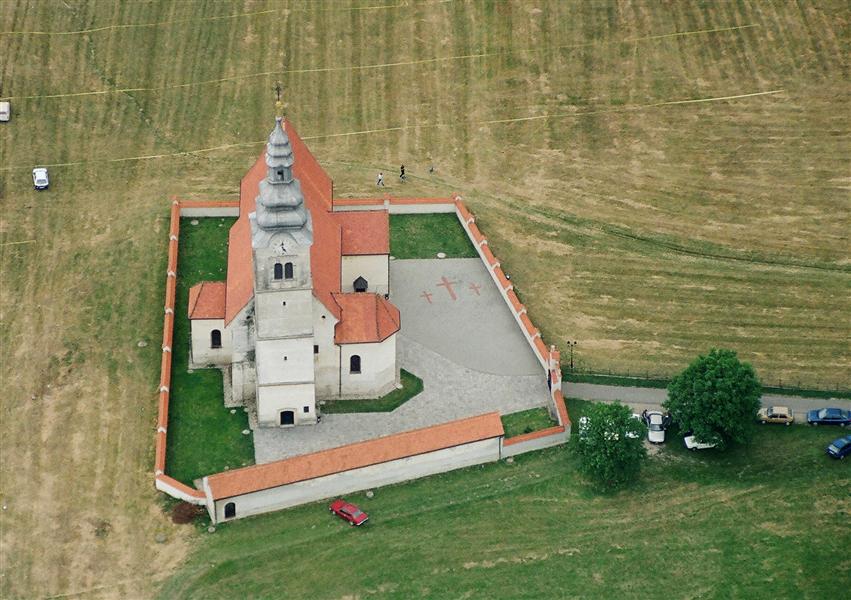 An older image of the church in Nedelišće © TZ Nedelišće
An older image of the church in Nedelišće © TZ Nedelišće
In a heartfelt letter Ciglar penned to his flock, which was read aloud at Mass last Sunday, he asked for their forgiveness. The Nedelisce parishioners seem uniform in their understanding of the situation.
“I wasn't surprised when the letter was read,” one is quoted as saying in 24 Sata. “We'd seen something happen between him and that girl before. That's no small thing with us. Still, we were all kind of rooting for their love story.”
The local diocese is in the process of assigning another young priest to the parish. It is unlikely that the new priest will be similarly tempted from his path, but, you never know. This is not the first time it has happened. A similar case was recorded in Nedelišće forty years ago when a priest left the service out of love for a woman.
For the latest travel info, bookmark our main travel info article, which is updated daily.
Read the Croatian Travel Update in your language - now available in 24 languages
Croatia's Catholics Return to Mass After 44 Days of Isolation
May 3, 2020 — Instead of holy water, the Catholic faithful at Zagreb's Our Lady of Lourdes Church used hand sanitizer.
"It is great to be here again," said Ana, a doctor, smiling as she entered according to Jutarnji List.
It's Saturday morning, ten minutes before 7 and 44 days since the last mass which the faithful were allowed to attend.
What will it all look like? Will it be crowded? Will the believers stick to the directions? Will there be a handshake in peace, communion at the mouth? Will there be social distancing, discipline? And will the priest put a mask on his mouth when he shares Communion?
There were 33 attendees at the mass, even though the church can accommodate a significantly larger number of believers. Some expected the turnout to be somewhat higher after 44 days of exile. But the epidemic and ban on public gatherings and listening to holy masses online on various social networks and platforms have done enough to break some habits.
"We broke the ice," two retirees said after the mass. "Many may not have been clear enough about how this would work, but it was all very organized and laid-back. Disciplined."
And, at least as far as this parish community is concerned, so it was. Instead of being blessed with water, the believers crossed themselves with their hands, which had been washed with disinfectant just before.
In this church, led by the Franciscans of Split, there were three tables in front of the entrance, with a disinfectant, and signs glued to the columns, on which the instructions to the faithful are very clearly given.
For those who do not know, the Church of Our Lady of Lourdes can accommodate at least 300 believers. Probably more. The church itself has about 70 benches that are arranged in three rows.
But this Saturday morning, the space is properly tidy. Every other bench is surrounded by a string, so every believer gets their own bench. Two meters of space.
Some wore protective masks over the mouth during mass, some wore gloves and others nothing. Also, there were no prayer cards or songbooks on the benches.
Before Mass began, priests offered confession, using the Spiritual Book Room as a confessional. The door was open, with directions greeting anyone who entered.
Even before confession, a disinfectant must be applied to hands, combining the medical and spiritual. Masks must be donned. If you don't have one, they are laid on a chair in the confessional itself. The priest is three meters away from the kneeling pole. There is no long spiritual discussion about sins. Only penance, a prayer of remorse, and forgiveness.
"Leave the room door open when exiting the confessional," the instructions at the confessional's exit say.
Mass itself had no sermons. Believers did not extend a hand for peace, and the priest gave instructions on how to behave. Before communion itself, he moved away shortly from the altar, disinfected his own hands, and put a mask around his mouth.
- First, communion goes the middle order. You go to the right, receive Communion on your hands and return to your benches on the left. Then goes the left row, then the right. Keep a distance,” he said.
And the people, probably used to the instructions they received from the national Civil Protection Directorate, listened. They even exited the church on the right side of the stairs. Disciplined.


